
|
| Name: _________________________ | Period: ___________________ |
This test consists of 15 multiple choice questions and 5 short answer questions.
Multiple Choice Questions
1. What do Doodle and Brother leave to do after lunch?
(a) Go rowing at Horsehead Landing.
(b) Search to see if they can find the ibis's mate.
(c) Box at Old Woman Swamp.
(d) Climb vines at Old Woman Swamp.
2. What does Doodle say when Brother tells him he is going to teach him to walk?
(a) It is not a good idea.
(b) Thank you.
(c) He will try.
(d) That he cannot walk.
3. What causes Brother to say that Doodle is a "burden in many ways" (3)?
(a) The doctor has made a long list of rules for taking care of Doodle.
(b) Doodle talks almost all the time.
(c) Brother's friends make fun of Doodle.
(d) Doodle is getting too heavy for Brother to pull in the cart.
4. When Brother says, of the hope they had when they started training, "Success lay at the end of summer like a pot of gold" (7), what should the reader understand from this simile?
(a) Their goal is an illusion that they will never reach.
(b) Their goal is dangerous and they should stop.
(c) Their goal is worth more than gold, to them.
(d) Their goal is to achieve something magical.
5. Who uses a book to find the name of the ibis?
(a) Daddy.
(b) Aunt Nicey.
(c) Doodle.
(d) Mama.
6. Where is the ibis perched?
(a) In the bleeding tree.
(b) On the grindstone.
(c) On the roof of the house.
(d) In the loft of the barn.
7. What does Brother know is covering the casket that he makes Doodle touch?
(a) Spiderwebs.
(b) Bird droppings.
(c) Cockroaches.
(d) Poison.
8. What evidence is there that Brother is pushing Doodle too hard?
(a) Doodle talks less and seems confused at times.
(b) Doodle begins to have trouble breathing.
(c) Doodle begins to have nose bleeds.
(d) Doodle becomes feverish and has nightmares.
9. After the incident where Brother makes Doodle touch the casket, what does Doodle cry out over and over?
(a) "Why?"
(b) "Don't leave me."
(c) "I hate you."
(d) "Am I going to die?"
10. What are Doodle's last words?
(a) "Don't leave me!"
(b) "I love you."
(c) "I told you."
(d) "Don't hurt me!"
11. When Doodle smiles at Brother for the first time, how does Brother feel?
(a) Happy and excited.
(b) Sad and angry.
(c) Confused and worried.
(d) Suspicious and numb.
12. What is the narrative point of view of "The Scarlet Ibis"?
(a) Third person limited.
(b) Second person.
(c) Third person omniscient.
(d) First person.
13. Who is the only person who does not like the name "Doodle"?
(a) The doctor.
(b) Mama.
(c) Aunt Nicey.
(d) Doodle.
14. When Brother finally decides to treat Doodle like a brother, where does he take him for the first time?
(a) The family graveyard.
(b) Old Woman Swamp.
(c) The cottonfield.
(d) Horsehead Landing.
15. Doodle has an active mind and talks a lot. What is his family's reaction to this?
(a) They are jealous of him.
(b) They make fun of him.
(c) They ignore him.
(d) They suggest that he might become a writer.
Short Answer Questions
1. When is the story being told?
2. Why does Brother treat Doodle roughly when he first starts taking him outside in his cart?
3. Who claims that dead birds are bad luck?
4. What does Brother say causes him to run home during the storm?
5. What do the "strange names" (8) talked about at the family dinner party allude to?
|
This section contains 636 words (approx. 3 pages at 300 words per page) |

|




